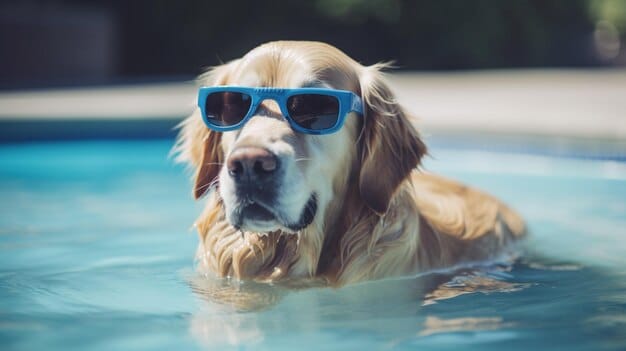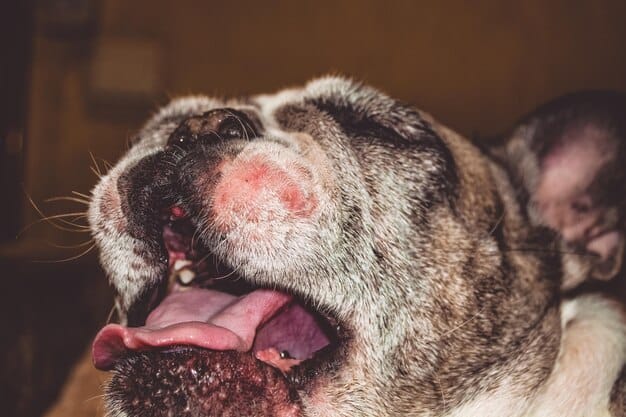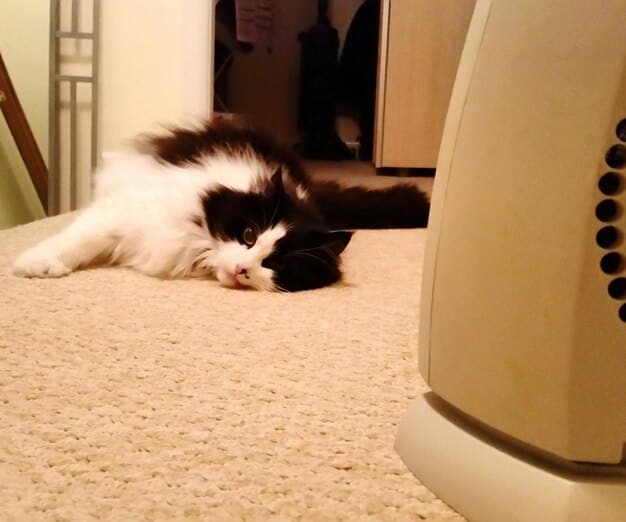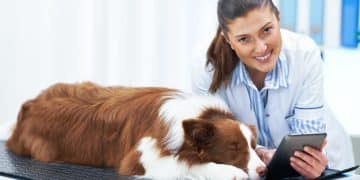Summer Heatstroke Prevention: Keeping Your Pet Cool & Safe

Anúncios
Summer heatstroke prevention is essential for pet owners to ensure their animals stay cool and safe during hot months, involving measures like providing shade, fresh water, and avoiding strenuous activities during peak heat.
Summer is a time for fun and outdoor activities, but for our furry friends, it can also be a dangerous time of year. Summer heatstroke prevention: keep your pet cool and safe during hot months, becomes paramount to ensuring their well-being.
Anúncios
Understanding Heatstroke in Pets
Heatstroke, also known as hyperthermia, is a severe condition that occurs when a pet’s body temperature rises to dangerous levels. Understanding its causes and symptoms is vital for effective prevention.
What Causes Heatstroke in Pets?
Several factors can contribute to heatstroke. Leaving a pet in a car on a hot day is a major cause, as the temperature inside a vehicle can rise rapidly, even with the windows slightly open. Another common cause is overexertion during exercise, especially in humid conditions. Brachycephalic breeds, such as bulldogs and pugs, are particularly vulnerable due to their shorter snouts, which make it harder for them to pant effectively.
Anúncios
Recognizing the Symptoms of Heatstroke
Early detection of heatstroke symptoms can significantly improve a pet’s chances of recovery. Key symptoms include excessive panting, drooling, weakness, disorientation, vomiting, and, in severe cases, seizures or collapse. If you notice any of these signs, it’s crucial to take immediate action.

Understanding the causes and recognizing the symptoms are the first steps in ensuring your pet’s safety. Being proactive and knowing what to look for can make all the difference in preventing a potentially fatal situation.
Providing Adequate Hydration
Hydration is key to helping pets regulate their body temperature. Ensuring your pet has access to fresh, clean water at all times is crucial, especially during the summer months.
Always Available Water
Make sure your pet has multiple sources of water readily available. Place bowls of water in various locations around your home and yard. When you’re on the go, carry a portable water bottle and bowl specifically designed for pets. Regularly check and refill water bowls to ensure the water is fresh and cool.
Encouraging Water Intake
Some pets may not drink enough water on their own. To encourage them to stay hydrated, try adding ice cubes to their water bowl. You can also try offering flavored water, such as diluted, unsweetened chicken or beef broth. Another option is to feed your pet wet food, which has a higher moisture content than dry kibble.
- Offer multiple water sources.
- Carry a portable water bottle for pets.
- Add ice cubes to water bowls.
- Try feeding wet food.
Proper hydration is a fundamental aspect of summer heatstroke prevention. By ensuring that your pet has access to plenty of fresh water, you can help them stay cool and comfortable throughout the hot summer months.
Creating a Cool Environment
Maintaining a cool environment is crucial for preventing heatstroke in pets. Simple adjustments to their living space can make a significant difference.
Indoor Cooling Strategies
Keep your home cool by using air conditioning or fans. Ensure your pet has access to shaded areas or cooling mats. Consider using a damp towel to gently wipe down your pet’s fur, which can help lower their body temperature. Avoid leaving your pet in direct sunlight, especially during the hottest part of the day.
Outdoor Considerations
When outdoors, provide plenty of shade by setting up umbrellas or canopies. Avoid walking your pet on hot pavement, as it can burn their paws. If you must walk them during the day, opt for grassy or shaded areas. Schedule walks during cooler times, such as early morning or late evening. Never leave your pet unattended in direct sunlight.

Creating a cool environment is a proactive approach to summer heatstroke prevention. By implementing these strategies, you can help your pet stay comfortable and safe, even when temperatures soar.
Adjusting Exercise Routines
Exercise is important for your pet’s health, but it’s crucial to adjust their routine during the summer to avoid overheating. Understanding the risks and making necessary changes can help prevent heatstroke.
Timing Your Walks
Avoid strenuous activities during the hottest part of the day, typically between 10 a.m. and 4 p.m. Schedule walks for early morning or late evening when temperatures are cooler. Choose shaded routes whenever possible to minimize exposure to direct sunlight. Keep walks shorter and less intense than usual.
Recognizing Overexertion
Monitor your pet closely for signs of overexertion, such as excessive panting, drooling, or lagging behind. If you notice any of these signs, stop the activity immediately and allow your pet to rest in a cool, shaded area. Provide them with fresh water and consider cooling them down with a damp towel.
- Walk during cooler times of the day.
- Choose shaded routes.
- Shorten walks and reduce intensity.
- Monitor for signs of overexertion.
By adjusting exercise routines and being mindful of your pet’s limits, you can ensure they stay active and healthy without risking heatstroke. Prioritizing their well-being during the summer months is essential for responsible pet ownership.
Special Considerations for Certain Breeds
Certain breeds are more susceptible to heatstroke due to their physical characteristics. Understanding these vulnerabilities is crucial for providing targeted care.
Brachycephalic Breeds
Brachycephalic breeds, such as bulldogs, pugs, and boxers, have flattened faces and short noses, which make it difficult for them to pant efficiently. Panting is a primary mechanism for cooling down, so these breeds are at higher risk of overheating. Extra precautions should be taken to keep them cool, such as limiting outdoor activity and providing ample shade and water.
Other High-Risk Breeds
Other breeds that are prone to heatstroke include long-haired breeds like Huskies and Saint Bernards, as well as overweight or obese pets. Long-haired breeds have thick coats that can trap heat, while overweight pets have difficulty regulating their body temperature. Regular grooming and weight management can help mitigate these risks.
Being aware of your pet’s breed-specific vulnerabilities is an important aspect of summer heatstroke prevention. By providing tailored care and taking extra precautions, you can help protect them from the dangers of overheating.
Emergency Measures for Heatstroke
Knowing how to respond in a heatstroke emergency can save your pet’s life. Immediate action is crucial to lower their body temperature and prevent lasting damage.
Immediate Cooling Techniques
If you suspect your pet is suffering from heatstroke, move them to a cool, shaded area immediately. Apply cool (not cold) water to their fur, focusing on the neck, groin, and armpits. You can also use a fan to help evaporate the water and cool them down. Avoid using ice water, as it can cause blood vessels to constrict and hinder the cooling process.
Seeking Veterinary Care
Even if your pet appears to be recovering, it’s essential to seek veterinary care as soon as possible. Heatstroke can cause internal organ damage that may not be immediately apparent. A veterinarian can assess your pet’s condition, provide necessary treatment, and monitor for any complications.
- Move pet to a cool area.
- Apply cool water to fur.
- Use a fan for evaporation.
- Seek immediate veterinary care.
Being prepared with emergency measures and knowing how to respond quickly can make a significant difference in the outcome of a heatstroke event. Always prioritize your pet’s health and seek professional veterinary care when needed.
| Key Point | Brief Description |
|---|---|
| 💧 Hydration | Ensure constant access to fresh water. |
| ⛱️ Shade | Provide shade outdoors with umbrellas or canopies. |
| 🚶 Exercise | Adjust routines to cooler times; avoid midday heat. |
| 🌡️ Monitoring | Watch for signs of heatstroke: panting, drooling, weakness. |
Frequently Asked Questions
Heatstroke, or hyperthermia, is a dangerous condition where a pet’s body temperature rises to a critical level, often due to exposure to high temperatures.
Signs of overheating include excessive panting, drooling, weakness, disorientation, vomiting, or even seizures. React quickly if you notice these symptoms.
Move your pet to a cool area, apply cool (not cold) water to their fur, and use a fan. Seek veterinary care immediately for further treatment.
Hydration is extremely important. Ensure your pet has constant access to fresh and clean water to help regulate their body temperature.
Yes, brachycephalic (short-nosed) breeds like bulldogs and pugs, as well as long-haired breeds and overweight pets, are more susceptible to heatstroke.
Conclusion
Protecting your pet from summer heatstroke requires vigilance and proactive measures. By understanding the risks, providing adequate hydration, creating a cool environment, and adjusting exercise routines, you can ensure your furry friend stays safe and comfortable throughout the summer. Remember to seek immediate veterinary care if you suspect heatstroke, as prompt treatment can save your pet’s life.






